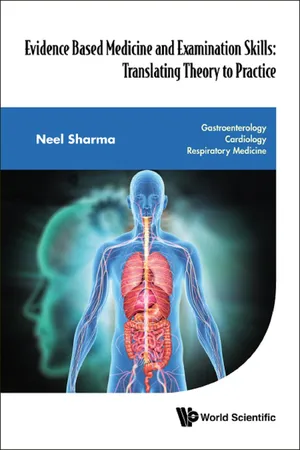![]()
Part I
Gastroenterology
Motility Disorders: Achalasia
Aetiopathogenesis
Achalasia is associated with gross dilatation of the oesophagus and contraction of the lower oesophageal sphincter (LOS) as well as loss of myenteric neurons. Inhibitory neurons containing vasoactive intestinal polypeptide (VIP) and nitric oxide synthase (NOS) are lost, as well as excitatory neurons containing acetylcholine. The condition is associated with a significant inflammatory response with the existence of T lymphocytes and autoantibodies. Viral factors have been linked to the disease and include measles and varicella zoster. Achalasia can also occur secondary to malignancy, Chagas’ disease, amyloidosis and sarcoidosis.
Symptoms
•Dysphagia for both liquids and solids
•Chest pain assumed to occur secondary to lactic acid production from fermentation of residual food debris
•Regurgitation secondary to retention of salvia and ingested food. Typically occurs in the recumbent position
•Weight loss
Signs
•Weight loss
•Possible chest signs secondary to aspiration
Differentials
•Angina
•Oesophageal cancer
•Oesophagitis
•Gastro-Oesophageal Reflux Disease (GORD)
•Scleroderma
•Oesophageal stricture
Investigations
An initial investigation of choice relies on a chest X-ray which typically shows an air fluid level. A barium swallow will demonstrate the classical appearances of a beak-like narrowing representing the non-relaxing LOS. Further investigations include a computed tomography (CT) scan which typically demonstrates a dilated oesophagus, and oesophageal manometry which will highlight the existence of an elevated basal LOS pressure. In some cases, however, LOS pressure may be normal or reduced. An endoscopy is useful in excluding secondary causes of achalasia such as carcinoma.
Management
Treatment comprises the use of calcium channel blockers, anti-cholinergics or nitrates which help to reduce the resting pressure of the LOS. Balloon dilatation has also been shown to reduce basal LOS pressure due to muscle fibre disruption. In some cases, patients may obtain relief from the use of endoscopic botulinum injection which helps to block cholinergic excitatory nerves in the LOS. From a surgical perspective, individuals may be able to undergo Heller myotomy which involves incision of the muscularis propria.
Diffuse Oesophageal Spasm
Aetiopathogenesis
Diffuse oesophageal spasm is thought to occur secondary to neural degeneration localised to nerve processes and inhibitory nerve dysfunction. Muscularis propria hypertrophy is also common.
Symptoms
•Chest pain
•Dysphagia
•Regurgitation
Signs
•Typically non-existent
Differentials
•Angina
•Oesophageal cancer
•Oesophagitis
•GORD
•Scleroderma
•Oesophageal stricture
Investigations
Barium swallow is the initial investigation of choice which demonstrates a corkscrew-like oesophagus. An oesophageal manometry can demonstrate the existence of swallow-induced contractions that are non-peristaltic in nature. A diagnosis is confirmed with >20% of wet swallows deteriorating into simultaneous onset contractions in the distal oesophagus.
Management
Treatment of diffuse oesophageal spasm often relies on anticholinergic agents, bougienage or botox-based therapies.
Gastro-Oesophageal Reflux Disease (GORD)
Aetiopathogenesis
One of the most common mechanisms for GORD is the occurrence of transient lower oesophageal sphincter relaxations (TLOSRs). During such activity, loss of the crural diaphragm occurs which impairs extrinsic sphincter function. Evidence also demonstrates that prolonged acid clearance is associated with worsening oesophagitis and a subsequent risk of Barrett’s oesophagus. This can occur secondary to impaired peristalsis and hypotensive contractions. Increased abdominal pressure is also linked to GORD which explains why obese individuals or pregnant women are at risk from the condition. Following meals gastric juice occupies the top of the meal close to the cardia — commonly known as the acid pocket — which in patients with GORD, is located more proximally with respect to the squamocolumnar junction. GORD patients are also noted to experience increased hypersensitivity to acid.
Symptoms
•Heartburn commonly after lying supine or bending over
•Regurgitation
•Dysphagia
•Chest pain
•Cough or wheeze secondary to aspiration of gastric contents
•Hoarseness
•Nausea
•Vomiting
Signs
•Examination is typically unremarkable
Differentials
•Motility disorders e.g. achalasia
•Oesophageal cancer
•Oesophagitis
•Gastritis
•Peptic ulcer disease
Investigations
The primary investigation of choice is an upper gastrointestinal (GI) endoscopy. This allows for detection of oesophagitis, strictures and Barrett’s oesophagus. The Los Angeles classification helps in the grading of reflux oesophagitis as follows:
•grade A oesophagitis: endoscopic abnormalities are restricted to one or more mucosal lesions with a maximum length of 5 mm.
•grade B oesophagitis: one or more mucosal breaks are present, with a maximum length of more than 5 mm but non-continuous across mucosal folds.
•grade C oesophagitis: mucosal breaks are continuous between at least two mucosal folds, but less than 75% of oesophageal circumference is involved.
•grade D oesophagitis: mucosal breaks encompass more than 75% of oesophageal circumference.
Manometry helps to determine LOS and oesophageal body function. It is undertaken in cases where there are persistence of symptoms whilst on treatment, recurrence of symptoms post-treatment, cessation as well as investigation of atypical symptoms. The use of a 24-hour pH probe is useful in cases where endoscopy is inconclusive. It helps to quantify GORD and allows for a correlation between reflux symptoms and episodes of reflux. Impedance monitoring is often used in conjunction with 24-hour pH monitoring helping to detect both acid and non-acid reflux.
Management
As per National Institute for Health and Care Excellence (NICE) guidelines, the treatment of GORD comprises proton pump inhibitors initially for up to two months followed by H2 receptor antagonists or prokinetic agents if there is a...
